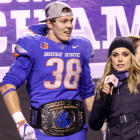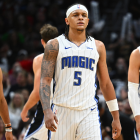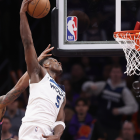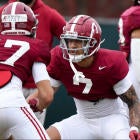Roquan Smith is the consensus top linebacker in the 2018 NFL Draft class. But will he be the first linebacker taken? Will he have the best career of his contemporaries?
Those questions lead to another, more wide-ranging question; what is the future of the linebacker position?
For the first 30 years after the AFL-NFL merger in 1970, America watched enormous downhill thumpers dominate when a large portion of offense featured running plays between the tackles or just outside them.
Over the past 20 years, we've all witnessed the linebacker position evolve. In the past five years, its morphed rapidly. Gone are the days when the run-stuffing, hard-hitting albeit relatively "slow" power 'backer is the premier member of his unit. With the nickel defense being played close to 70 percent of the time in today's NFL, the old strong safety has essentially become the new outside linebacker.
Now, playing in the 220-230 pound range isn't considered undersized. It's the new norm. Coverage ability has never been more vital for linebackers, and prospects deemed to lack sideline-to-sideline speed typically fall to the middle or late rounds of the draft. The smaller but quicker speedsters go early.
Alabama's Rashaan Evans is an old-school linebacker with some new-age flair. He's not a plodder by any stretch but is likely to measure in around 6-foot-2 and 235-240 pounds. His film is loaded with devastating hits between the tackles, textbook block-shedding, and quick run-play recognition.
Smith is a supercharged version of Evans with more explosive athleticism and the comparable ability to avoid blocks and beat blocks to excel against the run. He's also a fluid mover in coverage, which is vital. He had 137 tackles, 14 tackles for loss and two pass breakups in his final year at Georgia. To me -- and many others -- Smith's the owner of finest linebacker film in the class.
The Butkus Award winner is fast to sink into his zone and can run with backs down the field. He reminds me of Panthers star Thomas Davis who just so happened to attend Georgia and started his collegiate career at safety.
Despite injuries early in Carolina, in a way, Davis was stylistically ahead of the curve as a big safety playing linebacker, which was a catalyst for his vast NFL success.
Virginia Tech's Tremaine Edmunds and Boise State's Leighton Vander Esch represent the next wave, the latest "creation" at the linebacker spot at the professional level.
Both are around 6-4 and 250 pounds and move like they're at least two inches shorter and 20 pounds lighter. Their strides are almost unfathomably long, which leads to tremendous range toward the perimeter and when running in coverage. While neither possess the refined block-shedding ability or lightning-fast play diagnosing skills of Smith or Evans, in college, it didn't matter. They devoured ball-carriers and held up in coverage simply because of their outrageous athletic gifts at their mammoth size. At times in the NFL, their lack of polish will likely hurt them. However, how often will that be with the league appearing more and more like a 7-on-7 passing camp each season?
"This is the new trend ... basketball players at linebacker. It used to be basketball players transitioned to tight end, now we're starting to see them at the linebacker spot," one source said.
The source added, "Imagine LeBron James playing defense. At linebacker he'd cover so much ground so quickly. That's the thought with these bigger freak athletes at linebacker. Most importantly, the league's been looking for someone to cover the Rob Gronkowski-type tight ends. For a long time, the NFL's tried bigger safeties, but these new linebackers are really big and really athletic."
Edmunds and Vander Esch are expected to have vertical leaps in the upper 30-inch range at 6-4 and 250-plus pounds. A source told me to not be surprised if Vander Esch's three-cone time approached the highly coveted 7.00 second mark.
For perspective, 6-0, 223-pound Matt Milano had the highest vertical (35 inches) among linebackers at the 2017 combine, and only five off-ball linebackers had three-cones faster than 7.00 seconds.
Their height comes with length, which helps Edmunds and Vander Esch get to the football a split-second faster ... and is a luxury in coverage.
Vander Esch had 141 tackles, 8.5 tackles for loss, three interceptions, five pass breakups, and four forced fumbles in 2017. Edmunds registered 104 tackles, 14.0 tackles for loss, two pass breakups and three forced fumbles for the Hokies this past season.
According to a source, one NFC team will head into the combine with Edmunds and Vander Esch atop their board at inside linebacker. Smith is the No. 1 outside linebacker -- think the "playmaker" weakside spot -- for that club.
With the college and pro games being played through the air and outside the numbers more than ever with a variety of high-percentage wide receiver screens as an extension of the run game, I wonder if the block-shedding skills on inside power runs won't be (nearly) as valuable in the (short-term) future as they were even a few seasons ago.
A swarm of "matchup nightmare" tight ends has entered the league for years, and Edmunds and Vander Esch may be signaling the beginning of the precise second-level defenders to stop them.
I'll admit, I'm still an advocate for the stocky but springy off-ball linebackers with refined tools that allow them to dispatch blockers en route to impact plays against the run. Athletic talents and route recognition in coverage are clearly paramount. Think Luke Kuechly.
The presence of Edmunds and Vander Esch won't have an impact on Smith and Evans in the NFL. The latter pair has plenty of "new-age" skills and is likely to be productive for a long time at the pro level.
The Smith and Evans type won't instantly fall by the wayside because a unique version of linebacker will enter the NFL with them... the same way every play-call in the NFL next season won't be a trendy RPO.
However, the freakish duo of Edmunds and Vander Esch are at the outset of a new breed of linebacker to counter ever-changing NFL offenses that are briskly shifting toward a collegiate takeover.





















